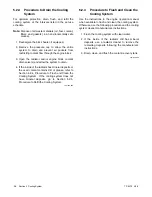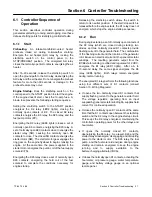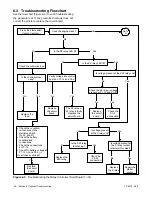
TP-6073 4/06
40
Section 7 Generator Troubleshooting
7.3 Separate Excitation
Separately exciting the generator can determine the
presence of an inoperative voltage regulator or whether
a running fault exists in the rotor and/or stator.
A
generator component that appears functional while
static (stationary) may exhibit a running open or short
circuit while dynamic (moving).
Centrifugal forces
acting on the windings during rotation or insulation
breakdown as temperatures increase can cause short
circuits.
Excitation Procedure:
1. Disconnect all of the leads from the voltage
regulator.
2. Disconnect the P6 (F1, F2) connector.
3. Connect a separate excitation circuit as shown in
Figure 7-2 or Figure 7-3. Connect an ammeter and
a 10-amp fuse in series with F1. Note and record
the ammeter reading.
4. Divide the battery voltage by the specified rotor
(brushed units) or exciter field resistance (cold) to
determine the exciter current.
Disconnect the
resistor leads and determine the exciter current
value using an ohmmeter.
See Section 1.3,
Specifications, for the normal values.
Rotor or Exciter Current
=
Battery Voltage
Rotor or Exciter Field Resistance
Example :
12 VDC
3.5 ohms
=
3.4 amps
+
—
+
—
9
8
7
3
2
1
4
5
6
TP-598652
10
11
A
1. Voltage regulator
2. (+) Terminal—(P10-1)
3. (--) Terminal—(P10-2)
4. 10-amp fuse
5. DC ammeter
6. 12-volt battery (DC)
7. Brushes
8. Collector rings
9. Main field (rotor)
10. Jumper lead
11. Engine ground
Figure 7-2
Separate Excitation Connections,
Brushed Units
+
—
+
—
F1
F2
P6
1
2
3
4
5
6
7
8
9
TP-593653
1. Voltage regulator
2. 10-amp fuse
3. DC ammeter
4. Battery
5. Ground to generator frame
6. Exciter armature
7. Exciter field
8. 10- or 15-ohm resistor
9. P6 connector
Figure 7-3
Separate Excitation Connections
Exciter Units
5. Start the engine and check that the ammeter
remains stable.
An increasing meter reading
indicates a shorted rotor or exciter field or
inoperative F1 resistor.
A decreasing meter
reading to zero or unstable reading suggests a
running open in the rotor or exciter or F1 resistor. If
the ammeter is stable, continue with step 6.
6. Check for AC output across the stator leads and
compare the output to the values in Section 1.3,
Specifications. If the output varies considerably
from those listed, a faulty stator, rotor, rectifier
module, or armature is the likely cause.
If there is no generator output during normal operation,
but output is available when the generator set is
separately excited, the voltage regulator is probably
inoperative.
Note:
See Section 1, Specifications, for the stator
output
voltages
(with
separately
excited
generator). These specifications are based on a
battery voltage of 12. Should the battery voltage
vary (11--14 volts), the resulting stator output
values will also vary.
Summary of Contents for 10EOR
Page 10: ...10 Safety Precautions and Instructions TP 6073 4 06 Notes...
Page 12: ...TP 6073 4 06 12 Service Assistance Notes...
Page 22: ...TP 6073 4 06 22 Section 3 Intake and Exhaust System Notes...
Page 26: ...TP 6073 4 06 26 Section 4 Fuel System Notes...
Page 30: ...TP 6073 4 06 30 Section 5 Cooling System Notes...
Page 38: ...TP 6073 4 06 38 Section 6 Controller Troubleshooting Notes...
Page 54: ...TP 6073 4 06 54 Section 8 Component Troubleshooting Notes...
Page 60: ...TP 6073 4 06 60 Section 9 Generator Disassembly Reassembly Notes...
Page 82: ...TP 6073 4 06 82...
Page 83: ...TP 6073 4 06 83...
















































